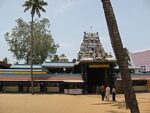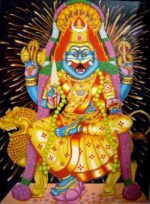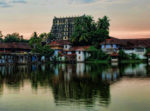Temple Name:
Alternate Spellings:
Attukal Temple
Listing Category
Significance:
Sabarimala of Women
Location:
Attukal
Address:
Manacaud P.O, Thiruvananthapuram, Kerala
695009
695009
District:
Thiruvananthapuram
Google Tag:
8.47°N 76.96°E
Phone No:
+91-471 – 2463130 2456456
Website:
Email id:
attukal@vsnl.com
Temple Timings:
4:30 AM – 12:30 PM, 5:00 PM – 8:30 PM
Temple Type:
Other
If Other is Chosen, pls specify:
Temple Trust
Presiding deity:
Bhagavathy Bhadrakali / Durga/ Kannaki
Sub Deities:
LORD SHIVA | LORD GANAPATHI | LORD MADAN THAMPURAN | GOD NAGAR
Offerings:
The offering of Pongala is a special temple practice prevalent in the southern part of Kerala and some parts of Tamilnadu.
Festivals:
The Pongala Mahotsavam is the most important festival of Attukal Bhagavathy Temple.
Kuthiyottam – Kuthiyottam performed by boys with the hope that the Goddess almighty would be pleased to bestow on them beauty inward and outward, health, wealth and happiness. Boys below the age of 12years make the offering of Kuthiyottam.
Thalappoli
Thalappoli by girls are popular rituals made on the pongala day. A stream of young girls below 12 years. dressed in traditional attire holding Thalappoli starts very early in the morning with the hope that the Goddess almighty would be pleased to bestow on them beauty inward and outward, health, wealth and happiness.
Vilakkukettu
Vilakkukettu as nercha reaches in Temple during night from 1st to 9th day of Pongala festival. One of the most spectacular sight of the festival is the vilakkukettu, in which beautifully decorated structures bearing idols and pictures of the Goddess are carried in the heads of the devotees, as they way to the temple from different parts of the city every night of festival accompanied by chendamelam music etc.
The Divine Procession
Other Festivals:
1. Mandala Vratham – Festival in connection with the annual Utsavam of Sabarimala
2. Vinayaka Chathurthi – Pooja to the Lord Ganapathy
3. Pooja Vaypu
4. Sivarathri – Siva Pooja- Special poojas are arranged in Siva Temple.
5. Karthika – (Devi’s star) in November – December – Karthika Deepam
6. Ayilya Pooja – Milk, flowers etc. offered to serpent God and special rites.
7. Aiswarya Pooia – On all fullmoon (Pournarni) days
8. Nirayum Puthariyum (Ramayana Parayanam)
9. Akhandanama Japam – 4th Sunday of every month
10. Ramayana Parayanam- During Karkadakam.
11. VISHU: This is on Malayalam month medam 1st , Vishukanni is arranged in the Temple.
12. Sahasrakalasham – This pooja is done during March/April. Devotees can book for different types of kalasham as vazhipaud during this pooja.
13. Narayaneeyam
14. Geetha Class and Geetha teaching class
Kuthiyottam – Kuthiyottam performed by boys with the hope that the Goddess almighty would be pleased to bestow on them beauty inward and outward, health, wealth and happiness. Boys below the age of 12years make the offering of Kuthiyottam.
Thalappoli
Thalappoli by girls are popular rituals made on the pongala day. A stream of young girls below 12 years. dressed in traditional attire holding Thalappoli starts very early in the morning with the hope that the Goddess almighty would be pleased to bestow on them beauty inward and outward, health, wealth and happiness.
Vilakkukettu
Vilakkukettu as nercha reaches in Temple during night from 1st to 9th day of Pongala festival. One of the most spectacular sight of the festival is the vilakkukettu, in which beautifully decorated structures bearing idols and pictures of the Goddess are carried in the heads of the devotees, as they way to the temple from different parts of the city every night of festival accompanied by chendamelam music etc.
The Divine Procession
Other Festivals:
1. Mandala Vratham – Festival in connection with the annual Utsavam of Sabarimala
2. Vinayaka Chathurthi – Pooja to the Lord Ganapathy
3. Pooja Vaypu
4. Sivarathri – Siva Pooja- Special poojas are arranged in Siva Temple.
5. Karthika – (Devi’s star) in November – December – Karthika Deepam
6. Ayilya Pooja – Milk, flowers etc. offered to serpent God and special rites.
7. Aiswarya Pooia – On all fullmoon (Pournarni) days
8. Nirayum Puthariyum (Ramayana Parayanam)
9. Akhandanama Japam – 4th Sunday of every month
10. Ramayana Parayanam- During Karkadakam.
11. VISHU: This is on Malayalam month medam 1st , Vishukanni is arranged in the Temple.
12. Sahasrakalasham – This pooja is done during March/April. Devotees can book for different types of kalasham as vazhipaud during this pooja.
13. Narayaneeyam
14. Geetha Class and Geetha teaching class
History:
Mythological Background
The story goes that the Goddess Bhagavathy revealed herself to a fervent devotee of a notable family viz. Mulluveettil family. It is said that one evening a young girl appeared before the head of the family while he was performing his oblations in the Killi river and requested him to help her cross the river. Impressed by her charismatic demeanour, the- old man bent before her with awe and reverence and not only helped her cross the river but took her to his house nearby. Strangely enough, while the household members were amidst preparations for intending a warm welcome to the young girl, she vanished. That very night she appeared as an icon before the old man in his dream and demanded that he should establish an abode for her in the nearby sacred ground of shrubs and herbs (kavu), at a consecrated spot marked by three lines. The next morning the old man went to the spot revealed to him in the dream and to his great surprise he did find three marks indented on the ground.
He lost no time in erecting a temple on this consecrated spot to house the Goddess. Many years later, the building was renovated by the local devotees. They also installed a beautiful and majestic icon of the Deity with four arms, bearing weapons of destruction in each, like spear, sword, shield etc. The consecration ceremony of this Exalted Being was performed by no less a person than the high priest of the Badarinath Temple.
The Attukal Bhagavathy Temple, one of the ancient temples of South India, is popularly described as Sabarimala of the Women, as women form the major portion of devotees. The Goddess in the temple of Attukal is worshipped as the Supreme Mother, creator of all living beings and the mighty preserver as well as destroyer of them all. The pilgrims from all over the country, who visit Sree Padmanabha Swamy Temple and worship the Lord, do not consider their visits complete without the visit to the shrine of the supreme Mother Attukalamma. Vishnumaya took the incarnation of Bhagavathy to annihilate the evil and protect the good in the world in the present Era namely Kaliyuga.
Attukal Bhagavathy is supposed to be the divinised form of Kannaki, the famous heroine of Chilapathikaram, written by Elenkovadikal,the Tamil Poet. The story goes that after the destruction of ancient city of Madurai, Kannaki left the city and reached Kerala via Kanyakumari and on the way to Kodungalloor took a sojourn at Attukal.
Kannaki is supposed to be the incarnation of Parvathy, the consort of Paramasiva. The all powerful and benign Attukal Bhagavathy reigns eternally supreme at Attukal and nurses devotees as a mother does her children. Thousands of devotees from far and near flock to the Temple to bend before the Goddess with awe and reverence to prostrate and redress their affliction and agony.
The story goes that the Goddess Bhagavathy revealed herself to a fervent devotee of a notable family viz. Mulluveettil family. It is said that one evening a young girl appeared before the head of the family while he was performing his oblations in the Killi river and requested him to help her cross the river. Impressed by her charismatic demeanour, the- old man bent before her with awe and reverence and not only helped her cross the river but took her to his house nearby. Strangely enough, while the household members were amidst preparations for intending a warm welcome to the young girl, she vanished. That very night she appeared as an icon before the old man in his dream and demanded that he should establish an abode for her in the nearby sacred ground of shrubs and herbs (kavu), at a consecrated spot marked by three lines. The next morning the old man went to the spot revealed to him in the dream and to his great surprise he did find three marks indented on the ground.
He lost no time in erecting a temple on this consecrated spot to house the Goddess. Many years later, the building was renovated by the local devotees. They also installed a beautiful and majestic icon of the Deity with four arms, bearing weapons of destruction in each, like spear, sword, shield etc. The consecration ceremony of this Exalted Being was performed by no less a person than the high priest of the Badarinath Temple.
The Attukal Bhagavathy Temple, one of the ancient temples of South India, is popularly described as Sabarimala of the Women, as women form the major portion of devotees. The Goddess in the temple of Attukal is worshipped as the Supreme Mother, creator of all living beings and the mighty preserver as well as destroyer of them all. The pilgrims from all over the country, who visit Sree Padmanabha Swamy Temple and worship the Lord, do not consider their visits complete without the visit to the shrine of the supreme Mother Attukalamma. Vishnumaya took the incarnation of Bhagavathy to annihilate the evil and protect the good in the world in the present Era namely Kaliyuga.
Attukal Bhagavathy is supposed to be the divinised form of Kannaki, the famous heroine of Chilapathikaram, written by Elenkovadikal,the Tamil Poet. The story goes that after the destruction of ancient city of Madurai, Kannaki left the city and reached Kerala via Kanyakumari and on the way to Kodungalloor took a sojourn at Attukal.
Kannaki is supposed to be the incarnation of Parvathy, the consort of Paramasiva. The all powerful and benign Attukal Bhagavathy reigns eternally supreme at Attukal and nurses devotees as a mother does her children. Thousands of devotees from far and near flock to the Temple to bend before the Goddess with awe and reverence to prostrate and redress their affliction and agony.
Updated on:
05/07/2019 by Komal
Temple Name:
Alternate Spellings:
Brahmapuram Sree Mahalakshmi Pratyungira Devi Temple | Atharvana Bhadrakali
Listing Category
Significance:
She is worshipped to bounce any ill effects caused by black magic (Abhichara), evil eyes/ words (curses) etc
Location:
Sasthamangalam, Trivandrum
Address:
Brahmapuram Sree Mahalakshmi Pratyangira Temple, Sasthamangalam, Trivandrum – 10
10
10
District:
Thiruvananthapuram
Google Tag:
8.5149° N, 76.9720° E
Phone No:
0471-2724969 +919895559402
Temple Timings:
0471-2724969, +919895559402
Temple Type:
Other
If Other is Chosen, pls specify:
Independent
Presiding deity:
Pratyangira Devi
Sub Deities:
NA
Offerings:
This temple does Amavasya pooja and Pratyangira poojas.
The most important rituals here are doing pradakshinam of the Devi 12 times with a coconut in hand and then breaking it.
A Homam is also performed on Amavasya Days.
The most important rituals here are doing pradakshinam of the Devi 12 times with a coconut in hand and then breaking it.
A Homam is also performed on Amavasya Days.
History:
The avatar of Narasimhi or Prathyangira Devi has two different concepts in Hindu mythology.
The story of Maha Pratyangira : Narasimha after killing Hiranyakashipu was still angry and all the devas couldnt control his anger and rage. To ensure that Hiranyakasipu’s brand of evil is forever banished from the universe, Narasimha consumed every drop of Hiranyakashipu’s blood and then wore the demon’s mangled body as a garland. So the devas went to Lord Siva and he took his gory from of sarabha. Narasimha and Sarabha had a long fight, but some what was still uncontrollable. To bring the whole thing in peace, from sarabha’s third eye he made a even more gory form of Maha Pratyangira. Even by the sight of Her, narasimha and all became cool. Her ugra roar made all things calm.
Narasimhi is one of the Matrikas or Mother Goddess of Hinduism. Goddess Narasimhi is regarded as the power of Lord Narasimha, the lion-man avatar of Mahavishnu. The goddess is popularly worshiped by the name Pratyangira Devi, the goddess with a lioness’s face and a human body. She is also known as Atharvana Bhadrakali and Narashimhika (in Kalisahasranama Stotram). The goddess is depicted with four hands holding Trishula (trident), Shankha (conch shell), Chakra (discus), Gada (mace). However in some scriptures, Narasimhi is said to have 2,000 hands with multiple weapons and a thousand tongues.
According to Vaishnavites, Goddess Lakshmi took the form of Narasimhi to calm down the rage of Narasimha after killing Hiranyakashyupu.
According to Shaivaite, she is an incarnation of Goddess Shakti and she appeared from the wings of Sarabheswara, the ugra avatar of Lord Shiva
The story of Maha Pratyangira : Narasimha after killing Hiranyakashipu was still angry and all the devas couldnt control his anger and rage. To ensure that Hiranyakasipu’s brand of evil is forever banished from the universe, Narasimha consumed every drop of Hiranyakashipu’s blood and then wore the demon’s mangled body as a garland. So the devas went to Lord Siva and he took his gory from of sarabha. Narasimha and Sarabha had a long fight, but some what was still uncontrollable. To bring the whole thing in peace, from sarabha’s third eye he made a even more gory form of Maha Pratyangira. Even by the sight of Her, narasimha and all became cool. Her ugra roar made all things calm.
Narasimhi is one of the Matrikas or Mother Goddess of Hinduism. Goddess Narasimhi is regarded as the power of Lord Narasimha, the lion-man avatar of Mahavishnu. The goddess is popularly worshiped by the name Pratyangira Devi, the goddess with a lioness’s face and a human body. She is also known as Atharvana Bhadrakali and Narashimhika (in Kalisahasranama Stotram). The goddess is depicted with four hands holding Trishula (trident), Shankha (conch shell), Chakra (discus), Gada (mace). However in some scriptures, Narasimhi is said to have 2,000 hands with multiple weapons and a thousand tongues.
According to Vaishnavites, Goddess Lakshmi took the form of Narasimhi to calm down the rage of Narasimha after killing Hiranyakashyupu.
According to Shaivaite, she is an incarnation of Goddess Shakti and she appeared from the wings of Sarabheswara, the ugra avatar of Lord Shiva
Updated on:
05/07/2019 by Komal
Temple Name:
Alternate Spellings:
Padmanabhaswamy Temple, Anantha Padmanabhaswamy temple
Listing Category
Significance:
To get rid of illness | For general well-being
Location:
Thiruvananthapuram East Fort
Address:
The Executive Officer, Mathilakom Office, West Nada, Sree Padmanabha Swamy Temple, Fort, Thiruvananthapuram
695023
695023
District:
Thiruvananthapuram
Google Tag:
8.482778, 76.943591
Phone No:
0471 2450233 0471 2466830
Website:
Email id:
info@sreepadmanabhaswamytemple.org
Temple Timings:
4:30 a.m. to 12:30 p.m and 4:30 p.m. to 8 p.m
Temple Type:
Other
If Other is Chosen, pls specify:
Hon. Supreme Court of India
Presiding deity:
Sree Padmanabha Swamy
Sub Deities:
NA
Festivals:
Painkuni Utsavam.
Chingam 1st
Vinayaka Chathurthi
Thiruvonam
Ashtami Rohini
Navratri Pooja
Valiya Ganapathi Homam
Swargavathil Ekadasi
Bhadradeepam
Kalabham
Sivarathri
Sree Rama Navami
Karkataka Sreebali
Sree Veda Vyasa Jayanthi
Niraputhari
Lakshadeepam
Murajapam
The different days on which the various Vahanams are taken out for the procession are as follows.
1st day of Utsavam – Simhaasana vaahanam
2nd day of Utsavam – Anantha vaahanam
3rd day of Utsavam – Kamala vaahanam
4th day of Utsavam – Pallakku vaahanam
5th day of Utsavam – Garuda vaahanam
6th day of Utsavam – Indra vaahanam
7th day of Utsavam – Pallakku vaahanam
8th day of Utsavam – Garuda vaahanam
9th day of Utsavam – Garuda vaahanam
10th day of Utsavam – Garuda vaahanam
Chingam 1st
Vinayaka Chathurthi
Thiruvonam
Ashtami Rohini
Navratri Pooja
Valiya Ganapathi Homam
Swargavathil Ekadasi
Bhadradeepam
Kalabham
Sivarathri
Sree Rama Navami
Karkataka Sreebali
Sree Veda Vyasa Jayanthi
Niraputhari
Lakshadeepam
Murajapam
The different days on which the various Vahanams are taken out for the procession are as follows.
1st day of Utsavam – Simhaasana vaahanam
2nd day of Utsavam – Anantha vaahanam
3rd day of Utsavam – Kamala vaahanam
4th day of Utsavam – Pallakku vaahanam
5th day of Utsavam – Garuda vaahanam
6th day of Utsavam – Indra vaahanam
7th day of Utsavam – Pallakku vaahanam
8th day of Utsavam – Garuda vaahanam
9th day of Utsavam – Garuda vaahanam
10th day of Utsavam – Garuda vaahanam
History:
The origin of the Temple of Sree Padmanabhaswamy is lost in antiquity. It is not possible to determine with any exactitude, from any reliable historical documents or other sources as to when and by whom the original idol of Sree Padmanabhaswamy was consecrated. The Temple has references in Epics and Puranas. Srimad Bhagavatha says that Balarama visited this Temple, bathed in Padmatheertham and made several offerings. Nammalwar, 9th century poet and one among the 12 Vaishnavite saints of the Alvar tradition, has composed ten hymns in praise of Lord Padmanabha. Some well known scholars, writers and historians, like the late Dr. L.A.Ravi Varma of Travancore, have expressed the view that this Temple was established on the first day of Kali Yuga (which is over 5000 years ago). The legends of the Temple are handed down through the centuries. One such legend which finds a place in the old palm leaf records of the Temple, as also in the famous grantha entitled “Ananthasayana Mahatmya”, mentions that it was consecrated by a Tulu Brahmin hermit named Divakara Muni. On the 950th year of Kali Yuga a reinstallation of the idol was done. In the 960th Kali year King Kotha Marthandan built the Abhisravana Mandapam..
Updated on:
05/07/2019 by Komal


